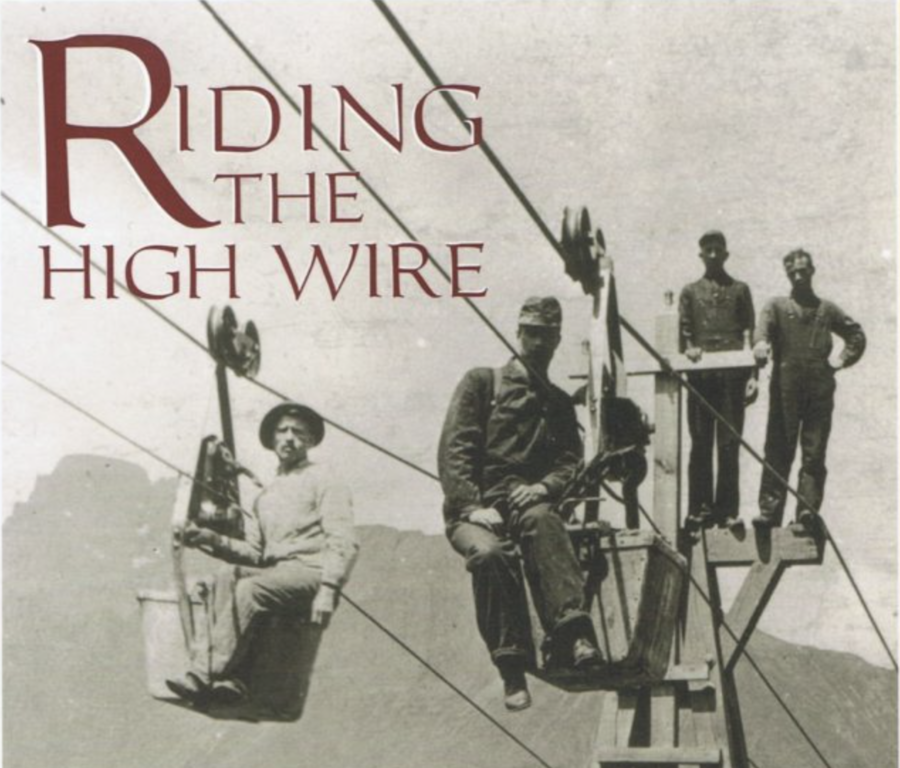It finally works! Well sort of…..
On the 11th May 1889, the Nepean Times enthusiastically reports: –
SUSPENSION TRAMWAY.
The suspension tramway has been got to work, at last. Two or three very satisfactory trials have taken place and we may expect to see the shale mine in full swing shortly, for which we are duly thankful, as anything that will make things look up a bit is very welcome.
On 24th May 1889 the Australian Star reports: –
Owing to some hitch in the machinery, there has been a temporary stoppage of work in the shale mine. I understand this has now been overcome, and it is expected to make a start within a few days. The shale tramway is a stout steel wire upon which trucks of shale are drawn from the bowels of the earth up to the mountain top. _[ This could be the work being done on the cutting ]
The very next day the Katoomba Times goes into raptures about the success of the shale mine:-
KATOOMBA SHALE MINE.
READERS will be glad to know that the cable tram to Mr. J. B. North’s shale mine is a perfect success. Mr. Schultz is under contract to deliver 4000 ton of shale in Sydney within a fortnight.
All hands are busy getting the shale from the mine to the reserve opposite the Katoomba engine-house, and the overseer has to give a helping hand with the trucks. On Wednesday, 381 trucks of shale were emptied on the reserve, and on Thursday, up to noon, 137 trucks of shale were shot out. Each truck contains half a ton of shale. This is good news for the whole of the colony.
On the 7th June 1889, Shale miners are being advertised for, but the next day the Katoomba Times reports that “the cable to the shale mine was out of gear yesterday” and further – The shale has been working grand for the last week. They have been delivering on an average 80 tons per day. There was a day and a half delay this week owing to the main rope giving way.
Having only been operating for 4 weeks, a major fault like “the main rope giving way” i.e. breaking, seems highly unlikely. Something that could be repaired in 6 days is more like a broken wire (or 2) in a track rope, or, more likely, excessive amounts of rope stretch in the haulage rope. This would necessitate cropping and resplicing. The haulage rope came from Gladstone, where it was in two sections, from the drive into the valley ( 750M) and from the drive to the railway siding (1450M), and still it wasn’t long enough. Katoomba total length was 3.410kM, i.e. the haulage rope total length was twice that at 6.82kM. A new section of 2.47kM had to be obtained and spliced in, and it would be this piece that stretched a lot, and remember that Gladstone had only done a few weeks work so its haulage rope would still have had some stretching to do. As explained above, the tension trolley would not take up this excess length, the excess would finish up in a big sag at the creek crossing. In the worst case a few buckets could just be waiting there for the slack to be taken up and be moving again!!!! A third possibility could be a splice “giving way”. There are now three splices in the haulage rope, always a potential source of trouble.
The Evening News on 11th June and the Australian Town and Country Journal on the 15th June 1889,report that “— Mr. E. C. Mestayer, M.I.C.E., has inspected the pendant tramway at Katoomba, and reports that with the present rope 50 tons of shale per day can be conveyed across the valley, and that with a new rope and some minor improvements this can be increased to 150 tons per day.”
The Sands Directory for 1889 has the following
MESTAYER RICHARD L.,
Consulting engineer, Beresford chambers,
52 Castlereagh St; p.r.”Symington,”
Parramatta Rd, Ashfield.
The Nepean Times reports more troubles on 15th June: –
THE SHALE MINE.
Operations at the Shale Mine have been again suspended, this time in consequence of the rail or standing rope, some part of which was used at the Gladstone Mine, giving way through wear and tear, and necessitating the introduction of a new piece of cable.
A new piece of standing rope can however be introduced relatively easily using the screwed collets. See fig 8.1 -8.3 below. The collet has a left and right hand thread, so the two rope ends are positioned together and the collet is screwed using a C spanner, pulling the ends together. The holding pins are then driven through the holes to stop it from unscrewing, IF the holes line up. Not always possible when they are being reused. The ropes were terminated inside the tapered sockets by separating the wires and pounding them with a drift to burr the ends and spread them out, a crude but effective method. The Bleichert handbook recommends placing tiny tapered wedges between the wires, not a very practical idea!

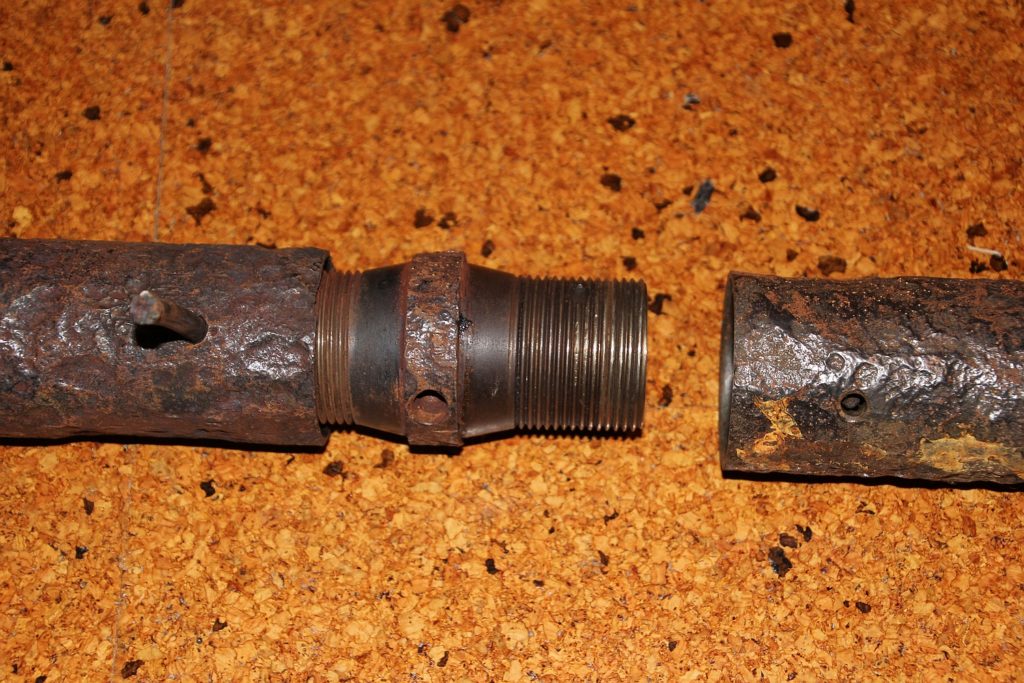

All was well again by the 22nd of June when The Katoomba times reports: –
Lots of shale being sent up by Mr. Schultz from the Mines; tons of it are stacked on the reserve near the dilapidated bridge on the Bathurst road. The tramway and cable are working smoothly.
During June and July daily ads were placed in Lithgow, Sydney, Newcastle and Wollongong papers for shale miners.
Accident at Ruin Castle
On 10th August, Mr Smith the Shale mine manager at Ruin Castle was injured in an accident on the “aerial tram”.
This newspaper article on the accident tells us quite a lot about the operation of the ropeway, but unfortunately by the time the journalist digested the facts and reissued them some confusion has arisen.
The paragraph is as follows: –
ACCIDENT AT KATOOMBA SHALE MINE
Mr. Smith, manager for Mr. Shultz at the shale mine in South Katoomba, experienced on last Saturday a narrow escape from serious injury on the aerial tram that runs from the mouth of the pit to near the engine-house of Katoomba Coal Mine.
While he was putting a skip on the wire tram, the engine, by some inadvertence (on whose part we have not been informed), started too soon, and Mr. Smith was caught between the hauling wire and the rail wire, the hauling wire having been triced up for the reception of the skip, which Mr. Smith was attending to at the time. On the starting of the engine, the tackle was carried away, and Mr. Smith fell a distance of 15 ft, or 20 ft., the skip coming after. For a short time Mr. Smith lay in-sensible, and when he recovered consciousness he proceeded home. Though severely shaken. Mr. Smith had no bones broken; his injuries consisting of a sprained ankle, a bruise on nose, and a big cut on the side, the latter having been done by the wire.
Our readers will be glad to hear that Mr. Smith is able to go to work again.
Now, my first question is why was Mr Smith “putting a skip on the wire tram”? If he was merely engaging a spider with the rope grip stopping the drive was not necessary. It is possible that he was re-roping a carrier and bucket, which had been taken off because of damage sustained during a trip from the unload station, and it was being returned to service. To guarantee a free spider being ready to engage the rope grip, the drive was stopped while the carrier was mounted on the track rope. Stopping the spider in a convenient place would be a matter of luck depending on how effectively the return sheave could be braked under the influence of the loaded buckets on their downhill journey to the creek from the mine, and where the spider was when the engine stopped. For this accident to happen the spider must have been toward the edge of the loading platform. This would make necessary “tricing” the haul rope to the track rope, to lift it to the correct height to engage the rope grip. Normally this correct height would be attained just where the track rope leaves the transport rail, because the haul rope slopes down from the small roller in front of the return sheave, which is slightly higher than needed, all the way to the roller on the first tower 20M away. The top of that roller is level with the platform deck.
It would take two men to lift the carrier without the bucket onto the track rope. The bucket would then be hung on its hooks at the bottom of the carrier.
The “tackle” to lift the haul rope would not need to be very strong. The rope is being held from moving by the brake on the return sheave.
As explained earlier, the method of informing the winder driver, to start or stop, was by an electrical circuit carried on the 3 km of fencing wire from the winder room to the loading station being completed to earth or the track ropes with a switch. This activated a buzzer in the winder room. The problem with this system, is that leakage of the current to ground, especially when wet, can cause the buzzer to sound inadvertently.
If this is what happened, and the driver started the winder, it would have no problem in breaking the tackle away.
The Katoomba Times reports “beautiful weather” for Saturday, so this is not likely.
Another possibility is that the brake on the return sheave slipped and allowed it to move. No mention is made of how the drive was stopped again, possibly the miner working the brake on the return sheave quickly screwed it in a bit tighter, so like the reporter I cannot say by “whose or what inadvertence”.
My second question is how Mr Smith could get “caught between the hauling wire and the rail wire”?
In my experience a simple chain block and tackle can do this job, with one hook over the track rope and one on the haul rope. Even a length of hemp rope can do the job, tied to the haul rope, then looped around the two ropes to form a 4 or 6 fall block, quite heavy weights can be lifted. The trick is that to be able to adjust the height of the spider easily, it works better if the tricing is on the outside or downrope direction of the spider, then you don’t have to lift the rope as high. The spider can then enter the rope grip by pushing the carrier back toward the spider, so this means that the carrier has to be lifted onto the track rope between the trice and the spider. The disadvantage of this is, if the haul rope moves, as it obviously did, the spider and carrier engage with the trice, and it pushes the trice and/or the carrier along, and the whole lot gets pushed along the track rope, to knock poor Mr Smith off the platform, and then foul on the first tower cross arm.
It’s a bit hard to see how the “wire” could have caused the “big cut on the side”, because as the trice and carrier are moving off the platform the haul rope is being lifted. It may have had a broken wire which could cause a cut, not an unexpected fault.

It is difficult to imagine exactly what caused Mr Smith to be engaging in this exercise. As the Bleichert System is designed to engage with the spider while the drive is moving, there would have had to be a problem with the rope grip, for this to be necessary. If a carrier arrived at the loading station with a broken rope grip, and there was no spare rope grip to hand, and no room on the storage rail, it would be necessary to lift it off the guide rail and prepare to “temporarily” lash or attach the carrier to the spider, so that it could be returned to the unload station, where better facilities were available to repair or replace it. To do this the spider would need to be stationary.
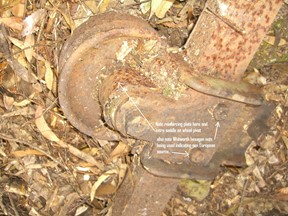
THE FIRST FAILURE
The sudden failure to pay the Miners on 31st August 1889 was the prelude to closure of the mine in September of 1889. Now, I had always thought that this was triggered by the breaking of the Outbye track rope, simply because I had always been told that the ropeway had broken a rope, and I was just looking for a suitable set of consequences to put a date on it. It seems that I was wrong!
This closure in September of 1889 seems to have been financial in nature. A mechanical failure of the ropeway would be unlikely to induce failure to pay the miners, but a financial one could.
By the 21st of September, they still had not been paid, but work at the Colliery was resumed on 5th October. On 17th and 23rd October Shale miners are being advertised for, so we assume that the Ruin Castle has reopened.
It seems that a deal had been done with the financiers, on the promise of raising more funds, because an Extraordinary General Meeting of KC&S was called for on 21st October to confirm the resolution of 30th September meeting that, the capital of the Company be increased to £90,000 by the issue of 20,000 Second Issue Preferent (sic) shares at £1 each. First call on these shares was 1/- with the second call not to be made for three months. These shares were only quoted twice on 28th Sept and 5th October 1889 at 1/6 each, so it seems that they were quite successful, but it was not enough.
[First issue Preferent shares sold for 2/2 during 1888.]
[A beautiful article in the Australian Star of 29th Oct 1889, extols the virtues of the Megalong Coal and Shale Company’s venture, further South of North’s mine. It seems that money was easily raised for these wild ventures. Well worth a read!]
However, doom approaches! On 30th Nov 1889 the SMH advertises a further Extraordinary General Meeting of Katoomba Coal and Shale, this time to adopt the resolution that “the whole of the Company’s property be sold and absolutely disposed of for such sum ……… as the Directors may think fit.’ They appointed people in London with Powers of Attorney to conduct the sale.
An illustration of the state of things occurs on the same date in the Katoomba and Nepean times where “William Hocking was severely cut about the thighs and one of his legs was badly broken, when a skip ran against a rail” ……………. The Nepean Times goes on to comment “
No one is particularly to blame, but from what I have gathered, the rolling stock and tramway are in a very dilapidated condition and I have heard several miners express their astonishment that there are not more accidents.”
Clearly money is tight.
On 6th December, the Managers Reports commence again reporting the amounts of coal raised, 1,780 tons for the fortnight, and again 28th Dec. 1,540 tons.
On 25th Jan 1890, a miner named Lychon was injured at the shale mine, so they were still working, but by Jan 31st “Work at the Coal and Shale Mines has not resumed”.
Rumours fly that the Company has been sold in London for £30,000, strongly denied by J. B. North in a letter to the Katoomba Times on 8th Feb 1890.
On 20th Feb a long article in the Illustrated Sydney News reports on the ropeway, and the fact that many skips have been lost in the valley, and that work has been temporarily suspended. This is the first that we hear of a strike that lasted until April. This article does falsely make the assumption that miners traveled to work in the ropeway buckets. Miners can be seen kneeling in the buckets in Kerry’s stereograph, taken in 1889, I think while the cutting was being made between Towers 12 and 13. (Fig 8.3) This is a highly processed photo the original being a 10×8 stereograph by Kerry. It does take a bit of imagination to see them!!!
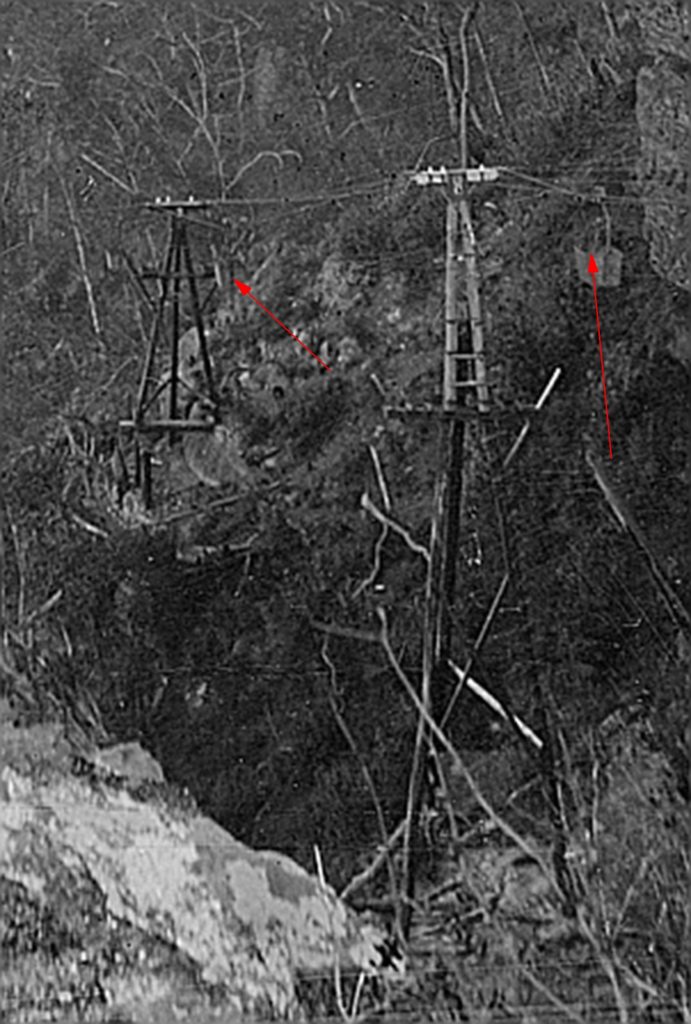
However, this was a common practice in photos of the time, even in the USA, so it doesn’t imply that miners were permitted to ride in the buckets, just demonstrates their bravado. (Fig 8.4)

The layoff continued until April, meanwhile North takes Schulze to court for non-payment of a promissory note. Schulze must have paid because the case was dismissed in March of 1890. Maybe Shulze’s payment improved the liquidity of KC&S, because the Mine is back in operation by the end of May and in June, North is standing for Council and is elected on 5th July, even though he had not lived in Katoomba since November of 1887.
On 14th March 1890 the Government Gazette reports at length the new Special Rules under the Coal Mines Act for Katoomba Coal and Shale Co..
From 22nd March 1890 to mid April work was resumed.
In April 1890 North as KC&S Co. submitted samples of shale to the New Zealand Exhibition in Dunedin. He had confidence in his mining business continuing. He also exhibited at the London Mining Exhibition in September 1890 as did AKO&M.
Also, on 5th July 1890 Nepean Times reports on more problems with the ropeway as follows: –
ACCIDENT TO THE SHALE TRAMWAY. A slight accident occurred on the overhead tramway to The Katoomba Shale mine yesterday. One of the shoes which hold the cables on the poles broke, allowing the cable to sag down, preventing the skips from running and blocking the line for some hours. The tramline appears to be unfortunate, as already there are half a dozen skips lying in the valley which have fallen from the wires and have been shattered in the fall.
My interpretation of this is that the track for the rolling shoe on Tower 18 broke its overtravel stop, Fig 55 Red arrow, and allowed the truck to run off the end, the track rope becoming disengaged. We have found the truck, Fig 53. This is the only way that a shoe could break, as all the standard shoes are just a solid casting resting on a cross timber, Fig 54, extremely unlikely to break. It was July and probably very cold, so rope shortening could have been a factor.
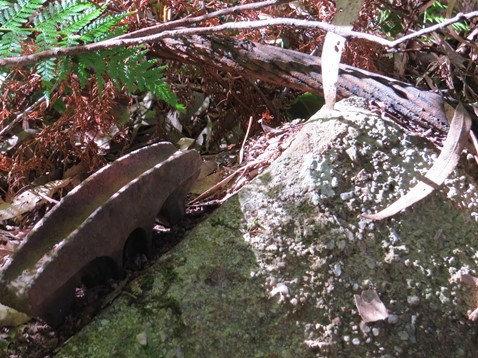
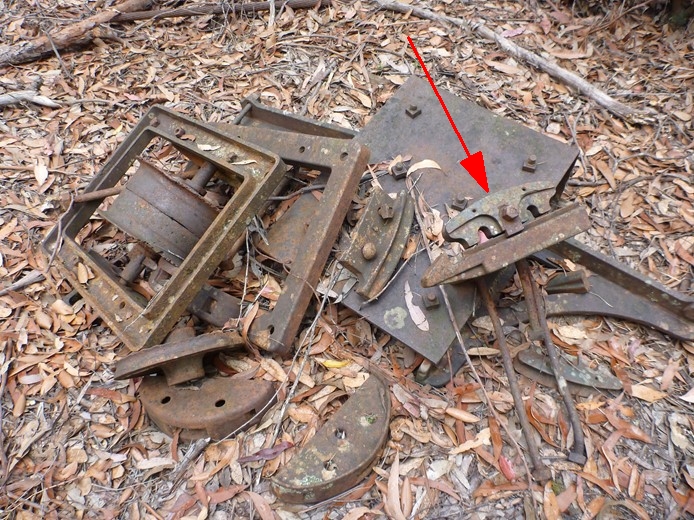
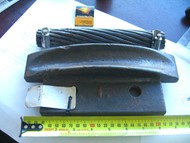
THE REBIRTH OF THE KATOOMBA COAL AND SHALE MINES
On 10th July 1890 an Emergency General Meeting of KC&S is held to confirm the sale of the company’s property to L.P Bain and the London Chartered Bank, and the week before on 5th July, Katoomba Times reports that a company has been formed with £80,000 capital to work the Katoomba Coal and Shale Mines.
In December of 1890 Australian Kerosene Oil and Mineral (AKO&M) wound up its company then registered a new Company with the same name. This was probably to get around a constitutional problem involved in acquiring leases and plant to develop Katoomba. NSW Government Gazette of 22nd Dec 1891 records the application from AKO&M for lease of the tramway from Por 74 to Por 37, to access the Glen Shale Mine, which was renewed in 1903 to recover shale.
AKO&M must have had an arrangement with Thomas Mort’s son Henry concerning Por 14 and 15 where they wanted to develop The Glen Shale Mine.
On 19th July 1890 the Katoomba Times reports that “The Katoomba Colliery changed hands this week” and on 2nd August a farewell dinner and commemoration was held for Joseph Edwards, Mine Manager for 5 years. An illuminated address was presented – I wonder where it is today?!?
“Mr. Edwards will stay on the Mountains till the Coal and Shale Mines are transferred to the other Company.” He was still there holding the explosives license for AKO&M in 1901! (Govt Gazette).
The upshot of all this was that Australian Kerosene Oil and Mineral Company from Joadja, leased North’s land which contained the Katoomba Coal Mine and the Ruin Castle Shale Mine. They bought the plant from KC&S and commenced opening up the Morts Glen Shale Mine in the Megalong Valley. It seems that the reported involvement of L. P. Bain and the London Chartered Bank was a temporary one to enable AKO&M to line up their ducks and start the new operation.
Lewis Potter Bain was a Stock and Share Broker, whose business was in 56 Pitt Street. John Britty North worked out of 90 Pitt St., and his son John G North worked out of 89 Pitt St.. L P Bain was an auditor of Sydney Meat Preserving Co Ltd. Mort’s company, which owned the land on which Morts Glen Shale mine would be developed.
The Sydney mail reports on 16th August that “The coal and shale mine here, which stopped work three weeks ago, has been idle since. Most of the miners have gone elsewhere in search of work. Distress will be felt by those remaining, unless work is soon resumed.“
On 23rd August Katoomba times reports: “
Numbers of miners have gone away since the colliery has been idle. Others are so tied that they must stop.
Mr. Joseph Edwards, manager of Katoomba Colliery, stays on the Mountains till the coal and shale mines are transferred to the new company.
The new company had representatives up yesterday to take over Katoomba Colliery.
Meanwhile J.B.North is trying to sell the 3,000 tons of Shale that he has in storage at The Shoots with ads in the SMH and others from 20th Aug until the 29th September. viz:
3000 Tons Kerosene SHALE, superior second quality, price 20s per ton, is now for sale, and ready for delivery at the rate of 200 tons per day into Government trucks at the Katoomba Siding.
Apply
J. B. NORTH
’90 Pitt-street.
On 29th September Katoomba Times reports:
Carters are very busy removing the shale from near Katoomba Shoots into the railway trucks. – so the sale must have been successful.
On 1st September KC&S dismissed all its workers and AKO&M re-employed them to start on 6th. September.
By 6th September The Nepean Times is reporting that work has recommenced but it is slow to get started due to the problem of re-employing miners.
On 25th October Nepean Times breathlessly reports: “The new company who have taken over the Coal and Shale Mines have started working the shale. There is some talk of their erecting an oil refinery. If so there is a prospect of a large industry starting here.“
AKO&M’s basic plan was to keep the Pendant Tramway and the coal mine/incline/tramway operating bringing in funds while developing Morts Glen. But all did not go well. On 22nd Nov 1890 the Daily Telegraph reports:
THE KATOOMBA COAL MINES.
Katoomba, Friday.— Hitherto the mines here have been fully supplied with trucks, but yesterday out of 30 required only six were available. Great discontent is expressed amongst the miners, as in consequence of the short supply they were idle all day. To-day the number of trucks was almost equal to requirements, but more could be utilised if available. All the coal goes away and none can at present be obtained from the agents for local wants. The mine owners have a large number of orders on hand and find it difficult to fill them, as only free labor is used.
This implies that difficulties are being had with the tramway in moving sufficient trucks to move the coal mine’s output, as I suspect that AKO&M were more interested in getting the more valuable Oil Shale to market via the ropeway, and it had to be transported up the Tramway too.
On Jan 21st 1891 the Daily Telegraph and others report that:
KATOOMBA, Tuesday.,
The new company are fast completing their arrangements for the fuller development of the coal and shale mines here. The surveyors have almost completed their survey of the route for the double line of railroad from the mouth of the coalmine to the shale. It is understood that next week the work of clearing the track will be commenced. Mr. Edwards is still retained as manager, but probably he will shortly be superseded by the manager from Joadja Creek, who arrived this week.
AKO&M worked on the tramway and the tunnel through Narrow Neck and the old coal mine all year. The pony tramway to connect the Ruined Castle Mine to the rope tramway was also in progress. Shale was being stockpiled at Morts Glen awaiting the completion of the tramway and the Pendant tramway was kept going apparently with little attention being paid to maintenance, because on Friday 29th April 1892 the Katoomba Times reported:
Last Saturday a very serious accident occurred at the Katoomba Mines to the suspended tramline from the cliff to the shale mines. The wire rope bearing several skips laden with shale and provisions broke and participated a great number of the skips into a creek in the valley, besides doing great damage to the line. Luckily no one was riding in the skips at the time; if that had been the case the result must have been fatal. However, matters are very serious as it is, for, we understand, nearly £400 worth of property was destroyed. It is great pity the rope did not hold out a little longer, as it was only intended to use this system until the completion of the [PONY] tramline to the ruined castle portion of the A.K.and O. Company’s property, which is under the care of Mr. Duff, and is progressing favorably.
It was a tossup whether the rope at Tower 14 or Tower 7 broke first. See picture at Fig 1.62 to see how close this rope was to breaking.
There are approximately 46 buckets and carriers spread across the Jamison Valley along the route of the ropeway today. Some of the buckets appear undamaged. After the outbound track rope broke at Tower 7, the carriers that were South of the Tension station on that rope at the time could still be recovered if the haulage rope was intact, and it seems that it was, because there are very few undamaged buckets on the ground across the valley. Kings photo shows 5 carriers between Tower 7 and 10 on each rope, so that is the 5 that could have crashed to the ground on rope break.
I had always wrongly believed that AKO&M moved the haulage rope from the Ropeway to the Tramway. We could have found out from the shale production figures reported to the Mines Department, unfortunately the Annual Reports for 1892-95 have not survived, but the rope was not long enough, 3.5kM for ropeway and 5kM for the tramway. But these newspaper reports show that the ropeway was still in use at the same time as the Tramway, and all the spiders would have had to be removed, leaving air gaps where they were in the core of the rope, a water trap and corrosion time bomb.
A considerable effort was made by AKO&M to recover as much as possible from the Valley after the track rope broke and before the ropeway was abandoned. Rope terminations containing whitemetal, [ an alloy of tin and lead used to anchor the rope inside the rope sockets] were cut off and carried out, as evidenced by the cut ends of track ropes across the valley. Approximately 4 tons of lead weights from the Tension Pit were carried out, as were three quarters of the transfer rails. Remarkably, the suspension chain for the outbound [broken] track rope was retrieved from the Tension Pit as far as Tower 10 before it was abandoned to hang over a small cliff. The buckets that were recovered were flogged around town as horse troughs. We retrieved one from the Katoomba Steam Laundry in the 1970s, it was very badly rusted and could not be saved.
When, eventually the haulage rope was retrieved, the Northern Unloading Terminal of the Ropeway, was unceremoniously cut away and dropped over the edge of the cliff. This bar, (Fig 8.8) which was probably a tieback for the track rope anchorage, was cut through with a chisel while under tension. It broke when the chisel was half way through. I have not been able to find the matching end in the Valley. This tangle of ropes and clips (Fig 8.9), is in the valley beside the present Scenic Railway Incline. It is the end of the inbound rope, and the clips and slings must have been part of the efforts to hold it back while it was disconnected from its anchor.
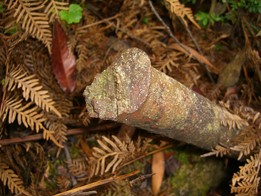

The tunnel through Narrow Neck was pierced on 17th Jan 1892, and on 5th Feb it is reported that AKO&M are going to “ship their first load of shale next week”. But this report is quite ambitious.
AKO&M planned to utilise the Bleichert ropeway drive to power their tramway to the Glen Shale mine. To do this the haulage rope, from the winder, over the edge of the cliff, down into the valley and around two sheaves set there, back up into the old ventilation adit, which was reused as the tension slope, then through the tunnels and tramway all the way out to the Glen Shale Mine diverting around the old Bleichert Counterwheels., this length of ¾” dia. 6/19 rope would weigh almost 9 tons.
In the meantime, KC&S was liquidated on 3rd March 1892 as North built up his Share Brokering business.
In 1890 KC&S produced 34,847 tons coal, and after the changeover, AKO&M produced 12,592 tons of coal. KC&S produced 2,500 tons shale, and AKO&M produced 607 tons of shale. The 607 tons came across the ropeway from Ruin Castle.
In 1891 AKO&M produced 27,034 tons coal at Katoomba, and 4,493 tons of shale at Katoomba via the ropeway. [20,000 tons from Joadja]. AKO&M are loading ships with shale for San Diego, Amsterdam, Rotterdam and Dunkirk. Most or all of this came from Joadja.
So, in 1892, AKO&M’s production of shale from Ruin Castle was interrupted until the pony tramway could be completed by Mr Duff.
A question still to be solved is how the Glen Shale Mine tramway was driven. It was obviously planned to use the Bleichert counter wheels for turnwheels on the tramway, but they had to be removed from the Bleichert drive, making it only able to transmit a smaller torque to the haulage rope with just a single half turn. Unless another sheave or sheaves were rigged to give more turns around the drive sheave.
Bringing the already mined shale from Morts Glen also had to wait until the ropeway was decommissioned, so the collapse worked to hurry things along a bit. It was always planned to use the Ropeway Drive for the Morts Glen Tramway. More production detail cannot be found without the 1892 report from DOM.
The phrase “laden with shale and provisions” also begs a question. Shale moved from the mine to the unloading terminal, provisions moved from the unloading terminal to the mine as food, utensils etc for the miners, supplies for the mine, picks, explosives, drills, candles, lamp wicks, kerosene for lamps. Seems ironic that they were mining Oil Shale from which was produced kerosene, which they needed to produce more shale! So, the Outbye rope broke at Tower 7, which means that only these outbound buckets between the drive and the tension station were affected, none of which were loaded with shale. Another example of journalistic license?
The newspapers of 1892 provide us with a keyhole view of happenings that year.
On Jan 22nd, 1892 Council paid an account of £20 to P Smith for building the Pedestrian Bridge over the Tramway at what is now the intersection of Kamilaroi Road and Peckmans Road. A later par mentions that the timbers on the bridge are to be strengthened with 6”x2” planks to enable horses to safely use the bridge.
On 5th February 1892, Katoomba Times reports that AKO&M are expected to bring in the first load of shale next week, and that a miner was killed, and three others injured by a charge exploding when being pressed into a drill hole. [ Thomas Lawless 10895/1892 Father’s name John – Mothers name Kate]
Katoomba Times reports on 4th March that AKO&M are busy loading a vessel with Katoomba Shale, [ from Ruin Castle via the ropeway].
On 11th March Katoomba Times reports that 200 miners are employed at Katoomba South, and the company is still taking on good shale miners.
The Mt Rennie Tunnel was pierced on 17th January and on 18th March meetings are being held to wind up KC&S.
8th April 200 men still going strong at Katoomba mines.
26th April AKO&M loading shale on a ship for Rotterdam.
23rd April. Outbye track rope breaks at Tower 7, but the miners are kept on in anticipation of the Pony Tramway coming into service and the cable tramway to Morts Glen Mine also.
13th May KC&S makes a 1/- call on its shares as part of the liquidation process. This means that it is still trying to raise money to pay its debts, even though it must have received a considerable sum from AKO&M via L. P. Bain. On 1st July North finds himself in Court for refusing to pay and is ordered to pay £119 plus costs. [ $16,441 in 2017’s dollars]
In a court case reported on 20th May 1892, Mr Joseph Edwards, Mine Manager, representing AKO&M concerning rates charged by the Council for land upon which the mine operated. Mr Edwards reported that in the last [municipal] year the Mine had output 22,462 tons of coal for which the average price was 5/3d. The rating was reduced from 9d per ton to 6d per ton. [ This is a Royalty on coal produced which these days is paid to the Federal Government, then it was paid to Council]
On 27th May an interesting comment appears in the Katoomba Times viz: –
Our readers far away must not think that 22,462 tons of coal is the whole of the output for last year of the A.K.O. and M. Co. They have a big shale mine, and it is the shale principally the company are working. It is said that had the company not to pay 6d. per ton royalty to a private party besides municipal taxes on the coal, the output of black diamonds would have been far larger.
The interesting part here is the payment of a 6d royalty to “a private party”. This can only be J.B North who is collecting a royalty on the coal produced. £561 for 1891. $77,500 today.
From this par it may be inferred that the shale is now being brought in from both Ruin Castle and Glen Shale Mine. On 9th September a miner was injured by “falling against a drawing rope”, so we may infer that the Glen Tramway was operating.
Here ends the long saga of the Bleichert Ropeway at Wentworth Falls and Katoomba.
Philip Hammon
Katoomba 25th Jan 2018. 1.01
22nd October 2018. 1.02
19th January 2019. 1.03
12th August 2019 1.04
